Military and Government agencies have specific communications needs. Providing real-time, secure high- speed broadband connectivity among war fighters, between command centers in the field and leadership back home; between emergency responders or for diplomatic organizations is key to a rapid and effective response to threats.

With severe budget constraints and the pressure to make every telecommunications investment count, service providers must provide innovative, secure, scalable and reliable network solutions that can easily and quickly be set up anytime, anywhere.
To achieve this, they need to choose the most net efficient, purpose-built, future-proof and scalable satellite networking solutions to support the government and military dynamic operations, and to provide the highest possible performance and differentiation of service that ultimately will increase the service quality.
Today’s Main Market Challenges
A high-performance communications network that can scale with emerging applications has become a critical requirement. Comprehensive business models are needed to adapt to changing business requirements and an overall strategy to provide differentiated services.
As a service provider, you have to minimize OPEX through increased bandwidth efficiency to create new revenue streams and better value to your customers. At the same time, you need a cost efficient platform that provides an entry-level, low cost hub configuration with the flexibility to expand as more remote terminals are deployed in the field and higher throughput is required to accommodate bandwidth-intensive applications. The increasing use of Unmanned Aerial Vehicles (UAVs) has added to this requirement due to the incremental streaming of imagery.
High Throughput Satellites (HTS) are going to put new demands on satellite networking platforms, one of these demands being packet processing performance. Networks will become increasingly complex as a result of High Throughput Satellite designs.
Another challenge is the ability to dynamically provide seamless, global connectivity where and when it is needed and efficiently manage beam switching. This is especially true for Communications-On-The-Move (COTM) where the applications operate on fast-moving aircraft, using a very small antenna and for troops constantly in motion, traveling across land, sea and air. In addition, there are issues such as satellite interference and Doppler that need to be addressed by ground equipment manufacturers.
Market Demand Drivers & Applications
What are the market demand drivers and applications driving this demand in the Government sector? The following is not a comprehensive list but are the most important:
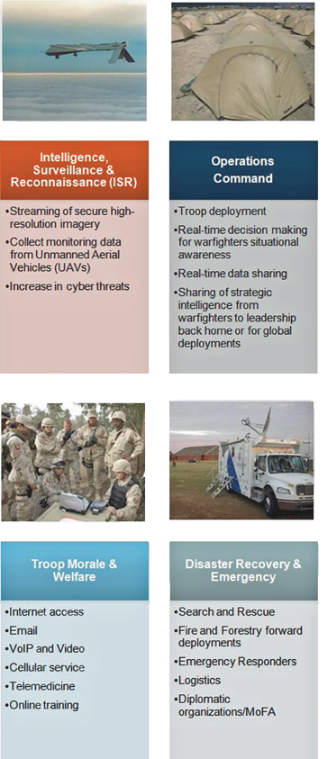
Figure 1: Applications Driving Demands in Government Sector
• The continuous investment in Command, Control, Communications, Computers, Intelligence, Surveillance and Reconnaissance (C4ISR) to support deployable forces despite budgetary cutbacks and changing operational requirements
• The need to optimize the use of satellite capacity due to controlled and tight budgets
• The growing use of satellite communications for real time transmission of images, video and voice
• The continued growth of welfare communications being an integral part of deployed military operations
• Dynamic bandwidth allocation ability for shifting bandwidth requirements during missions
• The use of unmanned aircraft as airborne relay stations to Beyond-Line-Of-Sight (BLOS) systems
End users in the Military and Government market require assured, secure, and reliable satellite communications to connect to their headquarters and communicate safely within closed user groups. For military and civilian agencies alike, the ability to stay connected all the times is mission-critical.
From communications between agencies to ongoing field and strategic-level military applications, satellite communication is crucial and must be up and running at all times. As budgetary constraints play a larger role in decision-making, the migration toward visual instead of textual information dramatically increases bandwidth demands. As secure VoIP and data transmission requirements evolve, and satellite transmission costs grow, government and military organizations face the challenges of delivering more data with greater reliability to more people and devices, while minimizing their Total Cost of Ownership (TCO).
As such, it is imperative for ground equipment manufacturers to provide practical, cost-effective and secure solutions to address dynamic market requirements, to help Governments work around constraints and respond to emerging challenges. These communications solutions enhance intelligence gathering and in-field decision making, often creating a competitive advantage in an otherwise hostile environment.
The solutions must also address “Bring Your Own Device” (BYOD) demands, by empowering troops deployed on the field to use their own smartphones or tablets to stay connected with friends and family through email and social media, or to stream video on their mobile devices. With this, they will be able to use a familiar communications device in a new and efficient manner, enabling them to focus on their critical tasks and increasing their effectiveness in conducting their primary mission.
A high level of communications security is paramount to ensure that the characteristics of the satellite systems and products are compatible with the operational security requirements of the Government sector.
Figure 1 provides a summary of the applications driving demands in the Government market.
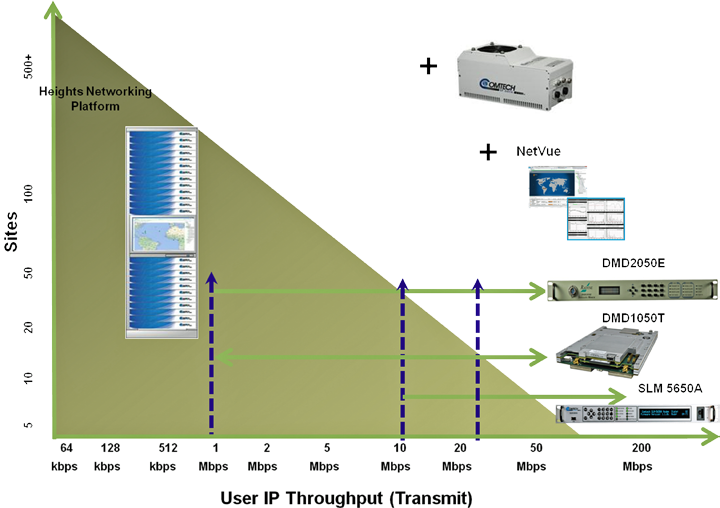
Figure 2. Product Positioning.
We at Comtech EF Data understand the challenges and the security requirements the Government sector requires. Our extensive range of satellite modems and networking platforms are bandwidth-efficient, provide high throughput and packet processing capabilities and are TRANSEC compliant and FIPS 140-2 Level 2 certified. In addition, our new RF products, LPOD-R block up converters (BUCs) are compact in size and weight which make them an ideal choice for remote sites with real estate constraints.
Product Positioning & Suitability For Government
Comtech has a number of products, the Heights Networking Platform, the SLM-5650A, the DMD-2050E and the DMD-1050T each addressing different aspects of the Government market. Supplemental to this and certainly enhancing our modems and networking platforms are our RF products. Any of our RF products, in any band and any power levels can be managed by our NetVue Network Management System. (See Figure 2.)
Facing Future Challenges
Comtech EF Data offers reliable, secure, flexible and cost-effective solutions for your satellite-based network infrastructure. Our solutions enable a seamless integration with existing infrastructures and are interoperable with any IP-based hardware.
Heights™ Networking Platform Solution
Designed to address the market challenges, Heights is a scalable networking platform that utilizes a fully managed platform with seamless integration into a service provider’s network. The most net efficient, flexible and powerful platform in the industry, Heights leverages a single comprehensive user interface teamed with a powerful traffic analytics engine that allows you to easily design, implement, monitor, control and optimize your network. The result is an elevated QoE for end users. Equipped to support the most demanding networks on traditional wide beams, new HTS spot beams or a combination of both, you can increase market share and grow revenues while controlling costs.
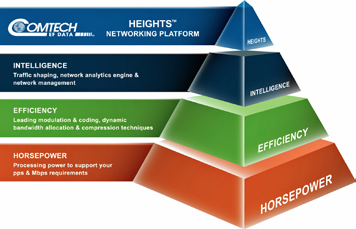
Figure 3: Heights Attributes
Heights Key Differentiators
• Comprehensive and dynamic bandwidth management
• Bandwidth efficiency
• Military-grade security
• Highest link availability with bi-directional Adaptive, Coding and Modulation (ACM)
• Advanced multi-level Quality of Service (QoS)
• True layer 2 operation
• Low latency and jitter
• High throughput and packets per second processing capacity
The intelligence, horsepower and efficiency of this platform as outlined in Figure 3 on the following page provide unmatched performance while minimizing the Total Cost of Ownership.
RF Products
Our LPOD-R family of Outdoor Amplifiers / Block up Converters (BUCs) deliver rated power, guaranteed to the transmit waveguide flange at the 1 dB compression point. There are three LPOD-R models available – PS .5, PS 1 and PS 1.5. Each LPOD-R consists of a SSPA module with the Monitor/Control Processor (MCP), a power supply and a fan assembly. To ensure the maximum usable output power with stable operation over a wide range of environmental conditions, the units feature a low loss combining technique and MCP-based temperature-versus-gain compensation. Figure 4 shows our range of LPOD-R BUCs.
SLM-5650A—Point-to-Point or Point-to-Multipoint (Hub-and-Spoke) Modem Comtech EF Data’s SLM 5650A (Figure 5) satellite modem is compliant with the strict requirements defined in MIL-STD-188-165A, modem types I, II, IV, V and VI for applications on DSCS, WGS and commercial satellites. Data rates from 8 kbps to 155 Mbps and symbol rates from 32 ksps to 64 Msps are supported.
The modem provides standard MIL-STD-188-114 (EIA-530 / RS-422), and EIA-613 (HSSI) serial interfaces, and can be optionally configured to support G.703 and Low Voltage Differential Signaling (LVDS) serial interfaces. It can also optionally be equipped with a 4-port 10/100/1000Base-T Ethernet Network Processor module that supports switching, routing and advanced Quality of Service protocols.
The SLM-5650A can be integrated with our dynamic bandwidth management engine to provide fully automated network and capacity management. An AES-256 TRANSEC module, compliant with the FIPS-140-2 NIST standard is also available as an option. All traffic (including overhead and all dynamic bandwidth control traffic) is encrypted when using the TRANSEC module. Advanced FEC and modulation capabilities are integrated with DoubleTalk® Carrier-in-Carrier® allowing for maximum state-of-the-art performance under all conditions. Direct Sequence Spread Spectrum (DSSS) is also available as an option in conjunction with LDPC-based FEC and BPSK modulation and spreading factors up to 512x.
DMD2050E—Point-to-Point Modem. The DMD2050E satellite modem (Figure 6) is designed to comply with the widest possible range of U.S. Government and commercial standards and is compatible with the largest number of satellite modems in the industry. It is fully compliant with MIL-STD-188-165A (all terminal types), fully complies with STANAG 4486 Edition 3, the draft standard MIL-STD-188-165B, as well as the IESS-308, IESS-309, IESS-310 & IESS-315 commercial standards.
The DMD2050E provides highly advanced and bandwidth efficient forward error correction (FEC). Advanced FEC options include Low Density Parity Check (LDPC), Turbo Product Codes (TPCs) and 165B Turbo Codes. Legacy support for Viterbi, Trellis, Concatenated Viterbi Reed-Solomon, and Sequential FEC are also included. A complete range of modulation types is supported including BPSK, QPSK, OQPSK, 8PSK, 8-QAM, 16-QAM and 16APSK.

Figure 4: Family of LPOD-R BUCs.
Like the SLM-5650A, advanced FEC and modulation capabilities are also integrated with DoubleTalk Carrier- in-Carrier. The DMD2050E supports Information Throughput Adaptation (ITA). Also referred to as Adaptive Coding and Modulation (ACM), ITA enables modems on each side of a point-to-point link to use the modulation and coding combination that maximizes throughput, and automatically adapts the optimum operating point as conditions (such as weather) change.
DMD1050T—Point-to-Point Modem. The DMD1050T is a card based satellite modem (Figure 7) designed for integration possibilities with manpack and portable earth station designs. It provides FDMA/SCPC performance and quality for Micro VSAT designs and offers high performance LDPC FECs for best bits/Hz and for small terminal capabilities.
The best jitter and latency performance of the DMD-2050E is found with this modem, which allows it to truly support HD Video ISR applications, higher data rate capacity, and gives better link margin and better ASI PSD margin, important for small antennas.
The DMD1050T based Micro VSAT enables direct landing via DMD2050E to any upgraded WIN-T Teleport. This is a minimum impact on the WIN-T Teleport structure, no additional or new Teleport equipment is needed! This also means there is a minimum impact on WIN-T Teleport personnel; minimal new training is required.
This is the Micro VSAT modem that provides a cost-effective extension to the WIN-T FDMA/SCPC footprint beyond the Battalion level, and is the high quality, high bandwidth alternative for Army Special Operations.
Spread Spectrum
Providing high-speed connectivity to mobile platforms such as aircrafts or UAVs is a challenge for COTM, especially when equipped with small lightweight antennas with low gain characteristics. Yet these small antennas require a high power for transmission over the satellite that can cause some Adjacent Satellite Interferences (ASI) if these adjacent satellites use the same frequency and polarization.
The challenge here is to avoid causing or being impacted by Adjacent Satellite Interference (ASI). This is achieved with the spread spectrum technology that spread the transmit signal over a wide frequency band, much wider in fact than the minimum bandwidth required to transmit the information being sent.
Spread spectrum results in operation with ultra-low power spectral densities. This enables use of small antenna apertures when adjacent satellite interference (ASI) is an important consideration. It can also be utilized to provide low probability of detection / intercept (LPD/LPI) operation and/or strong resistance to jamming. This technology is implemented in all our products supporting the Government market. Table 1 on the next page provides a feature summary of the different products and where each of these products fits.
Focus On QoE & System Interoperability
There are a multitude of vendors claiming the best optimization available but we believe that for a successful business model, service providers in the Government must place a focus on Quality of Experience (QoE).

Figure 5.
Figure 8 summarizes the key attributes needed in order to deliver the best QoE to end-users. Let’s delve into what that means for you.
Robust Intelligence
As troop deployment changes, the mission- critical communication network must also move with them. The ability to acquire, apply knowledge and gather network information and to dynamically manage bandwidth operations are key issues faced by service providers in this market.
Comtech EF Data’s solution is our NetVue™ Integrated Management System with dynamic bandwidth management.
NetVue leverages a single intuitive graphical user interface teamed with a powerful traffic analytics engine that acts as a user-friendly front-end to monitor and control network equipment and allows simplified design, implementation, monitor, control and network optimization for an elevated QoE. It is a comprehensive network management system that allows users to intelligently maximize resources, ensures network uptime and makes it easy for non-technical personnel to quickly set up and manage new remote sites.
NetVue is coupled with a dynamic bandwidth manager to provide scalable, dynamic satellite capacity management that facilitates bandwidth-sharing, automates space segment allocation and manages “pools” of available bandwidth. This feature provides the architecture to dynamically manage bandwidth operations without requiring dedicated bandwidth especially as troops and mobile remotes are constantly moving and bandwidth needs change. Users can remotely modify bandwidth allocations as requirements change automatically by the type of traffic or the traffic load, or manually, without requiring costly upgrades or site visits.
Using NetVue for network provisioning, monitoring and control reduces NOC personnel workloads and data duplication through operations optimization and automation. It also reduces CAPEX and Total Cost of Ownership (TCO) through increased efficiency of network usage and improves QoE through error minimization, proactive troubleshooting and trouble ticket prioritization.
Security
Military-grade security is a necessity and the top priority for the Government (civil and military) market. It is important to have ground equipment that is secure enough to mask the content, location, type and amount of information sent via satellite and hide satellite communications patterns.

Figure 6: DMD-2050E Modem
The way we are tackling this issue is with the implementation of Transmission Security (TRANSEC) for military applications. Our equipment is compliant with strict requirements defined in MIL-STANDARD 188-165A, STANAG4486 and is FIPS (Federal Information Processing Standard) 140-2 level 2 compliant.
Our satellite modems include a single FIPS card that will perform bulk encryption of all packets for transmission over the satellite regardless of the protocol, the format of data, or existing encryption on the incoming data. The TRANSEC module uses 256-bit AES for bulk encryption of any data and control information requiring encryption and provides the highest level of security for a satellite network.
Building a TRANSEC-compliant IP-based network prevents transmission activity from being used for intelligence gathering. Implementing FIPS 140-2 negates the risk of detection of repetitive data streams. Providing public-key cryptography for authentication ensures that remotes and hubs are authorized and validated in the network.
Availability & Reliability
The Government market demands efficient and reliable connectivity available on a 24/7 basis, even during the most adverse weather conditions. Given the remote and harsh environments where war fighters are deployed, it is key for any satellite communications solution to support the availability and required throughput.
These are concerns that we are addressing with the implementation of bi-directional Adaptive, Coding and Modulation (ACM) with Heights, our newest networking platform.
Bi-directional ACM embedded in Heights provides a unique and important feature to provide high availability and reliability. With the ability to maximize throughput under all conditions—rain fade, inclined orbit satellite operation, interference and other impairments—bi-directional ACM allows for automatic change in modulation and coding (MODCOD) in response to link conditions in both directions.
Each remote can achieve maximum throughput thereby maximizing network efficiency and availability. An average throughput gain of 100 percent (or more) can be realized, when compared to using traditional rain fade margins. Integrated in Heights with advanced QoS and other optimization technologies, bi-directional ACM maximizes network efficiency and availability to maintain desired service levels.
Efficiency, Flexibility & Scalability
With tight budget constraints ground equipment manufacturers must constantly strive to maximize efficiency, to improve bandwidth utilization and user throughput to stay ahead. Another challenge is to support multiple network configurations and frequency bands and have the ability to dynamically reallocate bandwidth where needed. This calls for the use of advances in modulation, coding gain, fade adaptation and intelligent data processing to provide increased capacity, improved reliability and substantial savings in bandwidth while maintaining contracted SLAs.
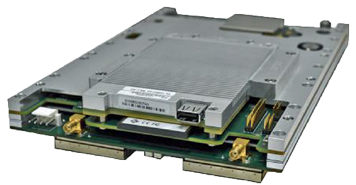
Figure 7. DMD1050T Micro VSAT Modem.
The Heights platform provides the most attractive economics for mission critical services via multi-layer optimization to provide highest spectral efficiency (user IP bits / Hz) in its class.
Implemented in the outbound, the Efficiency Boost (EB) waveform provides a 10 to 35 percent increase in efficiency over the DVB-S2 standard, controlling operating costs while providing up to 450 Mbps outbound user IP throughput. This is accomplished by virtually doubling the number of available MODCODs from previous Comtech products, introducing three optimized roll off factors (5 percent, 10 percent and 15 percent) in addition to 20, 25 and 35 percent and minimizing implementation loss to near theoretical operation.
Comtech EF Data’s next generation VersaFEC-2 high-performance LDPC Forward Error Correction (FEC) for the inbound is specifically designed to optimize application and RF performance and to allow our customers to control costs while providing the ever-increasing service levels that your end users demand.
VersaFEC-2 provides two operational modes, long-block (High Rate) and short-block. VersaFEC-2 short block, suitable for applications requiring minimal latency and jitter was designed for low to medium throughput. It is one of the two operational modes and provides 36 MODCODs (BPSK to 32-ARY) with better performance than the industry- proven VersaFEC at similar or better data latencies.
VersaFEC-2 High Rate, designed for higher throughput provides 38 MODCODs (BPSK to 32-ARY) with coding gain and spectral efficiencies better than DVB-S2 and on par with DVB-S2x at approximately 1/8 the data latency of these two standards.
Our dynamic bandwidth management capability (dSCPC) enables dynamic allocation and sharing of bandwidth and power among users. Bandwidth requests can be based on:
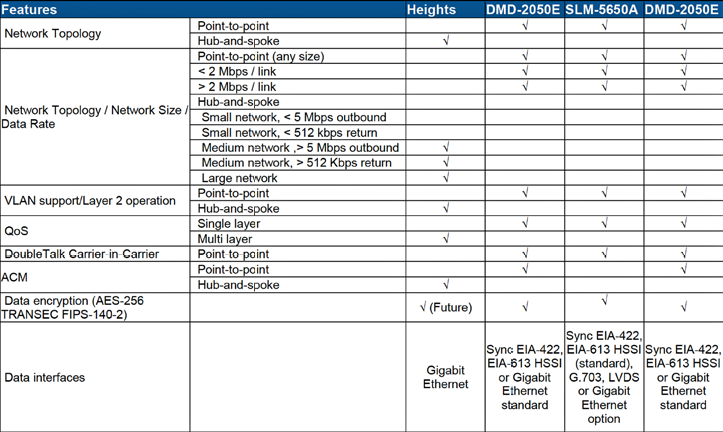
Table 1: Product Matrix for Government.
• Load switching based upon traffic level, providing additional bandwidth to remotes under heavy load conditions
• Type of Service (ToS) switching based upon pre-defined ToS / DSCP values, providing dedicated bandwidth for applications such as video and voice that require it.
Like competitors’ TDM/TDMA systems in our TDM/dSCPC networks, the outbound traffic from all remotes shares a common carrier, enabling the advantages of dynamic bandwidth allocation and associated statistical multiplexing. The difference between both systems is on the inbound link. With our system, in the dSCPC inbound link, each terminal is assigned a dedicated SCPC carrier. Dynamic allocation of capacity is achieved by varying modulation, FEC type and/or channel bandwidth of return carriers assigned to individual terminals in response to traffic demands.
How can service providers support multiple business models in a cost-effective manner and create service differentiation? Our solution resides in our Heights networking platform. Heights is a robust carrier class solution that supports multiple business models simultaneously, from full hub ownership, to collocation at a third party teleport facility to Virtual Network Operator (VNO) operations. The Heights platform comes with two hub configurations:
Heights Solo—Designed to support a single private network with one shared outbound and shared bandwidth pool for inbound connections.
Heights VNO—Designed to support the hosting of multiple VNO networks simultaneously, it provides multiple outbound carriers along with multiple bandwidth pools for inbound connections. The VNO capability is implemented with Heights to support multiple service providers over the same platform and create virtual customer networks based on secured access policies defined by the Host Network Operator (HNO). Three VNO models are supported.
Model 1
—Each VNO has separate hardware and a separate outbound/inbound bandwidth pool
—VNOs only share the NetVue NMS with bandwidth manager and the rack
—This model can meet the needs of a customer who wants to operate his own dedicated network in the service providers teleport using the service providers RF and antenna(s)
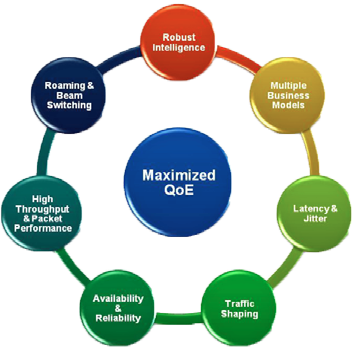
Figure 8.
Model 2
—The VNOs share the outbound bandwidth but have a separate inbound bandwidth pool
—In addition to sharing the NetVue NMS with bandwidth manager and the rack, the VNOs also share the hub modulator, traffic optimizer and hub multi-channel receiver
—The outbound bandwidth is shared among VNOs using multi-tier QoS bandwidth management
—Customers of a VNO share their VNO’s dedicated inbound bandwidth pool
Model 3
—The VNOs share outbound and inbound bandwidth pools
—All the hub equipment is shared
—The outbound bandwidth is shared among VNOs using multi-tier QoS bandwidth management
—The Inbound bandwidth pools are shared among VNOs
The scalability and flexibility of Heights removes the traditional barriers to entry in the satellite market and it is needed in this market with tight operating budgets. This allows service providers to tie their costs to revenues via a gradual network expansion and to quickly adapt to changing business requirements.
Higher Throughput & Packet Performance
For Intelligence, Surveillance and Reconnaissance (ISR) applications, as an example the streaming of secure high-resolution imagery and the collection of monitoring data from Unmanned Aerial Vehicles (UAVs) are bandwidth-intensive applications that require the satellite ground equipment to have the headroom to support the needed throughput.
Our remote equipment meets the unique, vertical-specific needs of end users in this market. Each remote in the network is assigned bandwidth on-demand from a shared bandwidth pool by the dynamic bandwidth management engine (dSCPC) and leverages its own optimal modulation and coding method.
The dynamic bandwidth allocation is ideal for these bulk file transfers since bandwidth is dynamically assigned where needed. Our Remote Gateway’s processors are capable of supporting high packets per second (pps), from 35,000 pps up to 140,000 pps with all multi-layer optimization features enabled, thus overcoming the packet processing limitation found in other competitive products on the market.
These performance levels enable the Heights Remote Gateway suite to support the most demanding of traffic mixes in a single unit. We leverage an extensive combination of modulation and coding for maximum efficiencies to provide the ability to transmit the high throughput needed.
Traffic Shaping
To ensure troops have access to the mission-critical information when needed, it is important to segregate bandwidth by real-time applications such as tactical updates for example versus non real-time applications across shared satellite bandwidth or prioritize critical monitoring functions to take precedence over non critical applications. Our multi-level QoS feature sets Comtech EF Data apart and leverages a powerful classification and traffic shaping engine that ensures the highest “value” traffic is prioritized, the most important services are uninterrupted and crucial applications continue to function properly.
With Government applications, particularly for military purpose, most of the traffic is encrypted before being sent over the satellite but for non-encrypted traffic a key feature for traffic shaping is compression. Our header compression technique looks inside the IP headers and examines the data flow to determine what we can remove as unimportant data before we send that information over the satellite, and then intelligently reinsert that data on the receiving end.

In addition, there is a lot of redundancy in data streams, some of which can be removed before transmission over the satellite. If a stream of data has been transmitted in the past, a much smaller representative set of data is sent along with a lookup location of past bit streams. By removing this unnecessary data, users can realize additional savings, increasing net efficiency even further. With lossless compression, Comtech EF Data ensures the complete accuracy of each bit on the remote end of the link, a key consideration for your end user’s mission critical applications. This type of accuracy requires significant horsepower on board the platform to be able to process this data at tens or hundreds of Mbps, which is what our Remote Gateways provide.
The result of leveraging these intelligent compression techniques is the conversion of a given number of “router bits” (those packets delivered to our units) into the least “satellite bits” (those transmitted through the spacecraft). Our equipment does all of this while providing the proper application-based and protocol- dependent Quality of Service (QoS) throughout the network.
Roaming & Beam Switching
Global connectivity and seamless coverage are main concerns for end users in the Government market. Furthermore with the use of small antennas on-board these moving platforms, it is important to mitigate Adjacent Satellite Interference issues and High Doppler Shifts. Moving vehicles or aircraft must provide effective communications even while on the move. Troops must stay connected and have access to critical intelligence while behind enemy lines. Providing connectivity for UAVs requires a seamless operation of several beams, different satellite footprints, multiple hubs and teleports.
The way we are addressing these concerns is with our Global IP roaming implementation and the implementation of spread spectrum as previously discussed.
How do we implement Global IP roaming and minimize automatic switching beam times? The Heights networking platform uses a mobility controller embedded in the Remote Gateway on board mobile platforms. This onboard mobility controller interfaces to the Antenna Control Unit (ACU) and maintains satellite footprint maps, initiates beam switching and handoff as the Remote Gateway moves through satellite footprints. It offers a common management interface for the mobility server and the ACU by providing a set of commands, information, interfaces and status queries.
In networks with a competitor’s platform the mobile location information is stored at the hub. Issues with hub based information arise during times when communications may be lost between the hub and the remote. In these cases no location or switching information is received from the hub and the remote may disengage from the network. With our Global IP roaming implementation, the remote does not need to be connected to the hub to handover from one satellite to another. Because the intelligence is on-board the mobile platforms, the handover decisions and parameters are intelligently performed on-board, thus minimizing automatic beam switching times and guaranteeing that connectivity is dynamically maintained on the move.
Capitalizing On High Throughput Satellites (HTS)
The Wideband Global SATCOM (WGS) constellation began in 2007 (with WGS-1) and even though there are six WGS satellites in orbit today, the Military still needs to use commercial satellites to augment its satellite capacity in order to address increasing bandwidth needs. As such, High Throughput Satellites with the combination of spectrum efficiency and performance of overlapping spot-beam with ultra-wideband transponders are an attractive option to the Government as a whole. HTS will enable increased data usage without having to launch more satellites. The potential of HTS to reduce costs, especially during these budget constraints times will be very attractive, particularly for airborne Communications-on-the-Move (COTM) and Beyond-Line-of-Sight communications (BLOS) systems.
Service providers must capitalize on this opportunity to address this increasing need for more capacity. For service providers, this means having a service delivery infrastructure to meet user experience expectations and to monetize differentiated service offerings.
Our Heights platform provides a scalable, powerful and future-ready satellite networking platform. It is scalable to support multiple business models, any satellite architecture and frequency band for a low cost of service entry. It is HTS-ready with the multiple outbound transmit capability to transmit multiple contiguous outbound carriers, one to each spot beam and to share demod banks across spot beams. It is a powerful platform with extensive MODCOD combinations allowing for maximum satellite link efficiencies embedded in the Remote Gateways with the processing power to deliver higher throughput to any given location with the same antenna and BUC sizes than with existing traditional satellites.
In Conclusion
Is your satellite networking infrastructure ready to meet tomorrow’s market demands? To achieve your business growth goals, you need a powerful, dynamic networking platform that outperforms the rest and guarantees optimal levels of service beyond a one- or two-year business case.
Comtech EF Data’s extensive range of satellite networking platforms, satellite modems, RF products and dynamic bandwidth management tools will provide you with the solution to address the Government market. Our newest networking platform, Heights is future-proof, reliable, flexible, scalable and HTS-ready with minimal site intervention, a key feature given the remote regions and environments where the military operate.
The platform meets the tight security requirements for this market and provides a higher QoE per user, at a lower cost per delivered bit, letting you increase your market penetration, expand your addressable markets, operate with better margins and minimize end-customer churn. Heights is a fully managed platform focused on the intelligence to enable dynamic allocation of bandwidth when and where it is needed, on efficiency and horsepower to maximize the Quality of Experience (QoE), all while minimizing the Total Cost of Ownership (TCO), and meeting stringent SLAs and tight security requirements.
comtechefdata.com
Frederick Morris is Vice President of Product Marketing for Comtech EF Data. In this role, he is responsible for the positioning and promotion of Comtech EF Data’s products. Previously at Comtech, he was Vice President of Global Sales Engineering, and was General Manager of Comtech EF Data Vipersat Network Products Group.
During his career, Morris has held various senior business development and technical marketing positions. Prior to joining Comtech EF Data, he was vice president of product management and development at Intelsat. Previous to Intelsat, he held the position of vice president of product management and sales support engineering at Verestar.
His extensive experience also includes senior level positions in product management and business development at SES Americom, Viacast Networks, and Hughes Network Systems. Morris holds a BSEE degree from the University of Connecticut and a MS in Technology Management from the University of Maryland.


